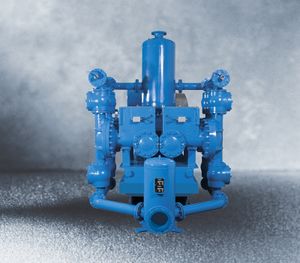Difference between revisions of "Membrane Pumps"
Jump to navigation
Jump to search
| Line 7: | Line 7: | ||
* Please start editing this page after the /noinclude | * Please start editing this page after the /noinclude | ||
* -------------------------------------------------></noinclude> | * -------------------------------------------------></noinclude> | ||
This | [[File:Membrane pump.JPG|thumb|right|Membrane Pumps]] | ||
'''Membrane Pumps''' also known as [[Diaphragm Pumps]] or Pneumatic Diaphragm Pumps are positive displacement pump that uses a combination of the reciprocating action of a rubber, thermoplastic or teflon diaphragm and suitable [[Valves]] either side of the diaphragm to pump a fluid. | |||
There are three main types of membrane pumps: | |||
* Those in which the membrane is sealed with one side in the fluid to be pumped, and the other in air or hydraulic fluid. The membrane is flexed, causing the volume of the pump chamber to increase and decrease. A pair of non-return check valves prevent reverse flow of the fluid. | |||
* Those employing volumetric positive displacement where the prime mover of the membrane is electro-mechanical, working through a crank or geared motor drive, or purely mechanical, such as with a lever or handle. This method flexes the diaphragm through simple mechanical action, and one side of the membrane is open to air. | |||
* Those employing one or more unsealed membranes with the fluid to be pumped on both sides. The membrane(s) again are flexed, causing the volume to change. | |||
When the volume of a chamber of either type of pump is increased , the pressure decreases, and fluid is drawn into the chamber. When the chamber pressure later increases from decreased volume , the fluid previously drawn in is forced out. Finally, the membrane moving up once again draws fluid into the chamber, completing the cycle. This action is similar to that of the cylinder in an internal combustion engine. | |||
Revision as of 08:13, 3 January 2013
Membrane Pumps also known as Diaphragm Pumps or Pneumatic Diaphragm Pumps are positive displacement pump that uses a combination of the reciprocating action of a rubber, thermoplastic or teflon diaphragm and suitable Valves either side of the diaphragm to pump a fluid.
There are three main types of membrane pumps:
- Those in which the membrane is sealed with one side in the fluid to be pumped, and the other in air or hydraulic fluid. The membrane is flexed, causing the volume of the pump chamber to increase and decrease. A pair of non-return check valves prevent reverse flow of the fluid.
- Those employing volumetric positive displacement where the prime mover of the membrane is electro-mechanical, working through a crank or geared motor drive, or purely mechanical, such as with a lever or handle. This method flexes the diaphragm through simple mechanical action, and one side of the membrane is open to air.
- Those employing one or more unsealed membranes with the fluid to be pumped on both sides. The membrane(s) again are flexed, causing the volume to change.
When the volume of a chamber of either type of pump is increased , the pressure decreases, and fluid is drawn into the chamber. When the chamber pressure later increases from decreased volume , the fluid previously drawn in is forced out. Finally, the membrane moving up once again draws fluid into the chamber, completing the cycle. This action is similar to that of the cylinder in an internal combustion engine.
